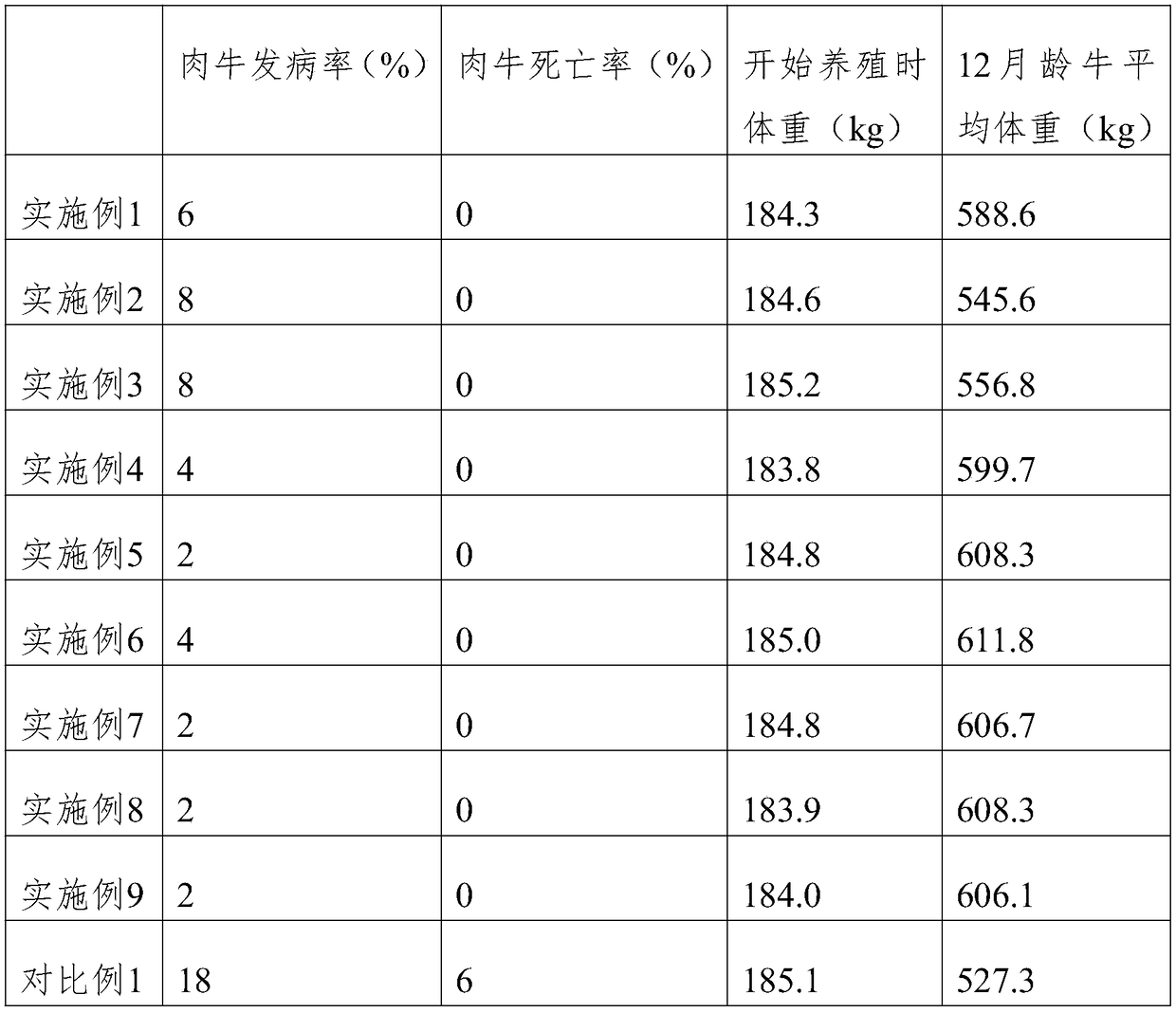Disease-resistant fattening breeding method for beef cattle
A breeding method and technology for beef cattle, applied in the field of livestock breeding, can solve the problems of endangering human health and increasing the residual amount of animal food and medicine.
- Summary
- Abstract
- Description
- Claims
- Application Information
AI Technical Summary
Problems solved by technology
Method used
Image
Examples
Embodiment 1
[0046] A disease-resistant fattening breeding method for beef cattle, comprising the following steps:
[0047] (1) Daily management: select weaned calves for feeding
[0048] a. Within 1.5 months after weaning, it is the adaptation period, and the growth period feed is fed. The growth period feed is obtained by mixing the following raw materials: 30kg of corn stalks, 30kg of corn, 17.5kg of straw, 8kg of cactus, and pseudo betel. 10kg, dahlia 13kg, chamomile 7.5kg, castor 3kg, salt 0.55kg, selenium supplement 0.02kg;
[0049] b. After the adaptation period ends, it enters the growth period and lasts for 4 months. The feed for the growth period is obtained by mixing the following raw materials: 28kg of corn stalks, 38kg of corn, 27.5kg of soybean meal, 17kg of cactus, 10kg of konjac, 10kg of perilla, and dahlia 13kg, chamomile 4kg, nettle 4kg, castor 6.5kg, salt 1.5kg, selenium supplement 0.045kg;
[0050] c. Enter the fattening period after the growth period, until 1.5 month...
Embodiment 2
[0060] A disease-resistant fattening breeding method for beef cattle, comprising the following steps:
[0061] (1) Daily management: select weaned calves for feeding
[0062] a. Within 1 month after weaning, it is the adaptation period, and the growth period feed is fed, and the growth period feed is obtained by mixing the following raw materials: 28kg of corn stalks, 28kg of corn, 15kg of straw, 10kg of cactus, and 12kg of false betel. , Dahlia 14kg, Chamomile 10kg, Castor 4kg, Salt 0.8kg, Selenium supplement 0.03kg;
[0063] b. After the adaptation period ends, it enters the growth period and lasts for 3 months. The feed for the growth period is obtained by mixing the following raw materials: 26kg of corn stalks, 36kg of corn, 25kg of soybean meal, 19kg of cactus, 12kg of betel, 12kg of perilla, and 14kg of dahlia , chamomile 5kg, nettle 5kg, castor 8kg, salt 2kg, selenium supplement 0.06kg;
[0064] c. After the growth period, enter the fattening period until one month be...
Embodiment 3
[0074]A disease-resistant fattening breeding method for beef cattle, comprising the following steps:
[0075] (1) Daily management: select weaned calves for feeding
[0076] a. Within 2 months after weaning, it is the adaptation period, and the growth period feed is fed, and the growth period feed is obtained by mixing the following raw materials: 32kg of corn stalks, 32kg of corn, 20kg of straw, 6kg of cactus, and 8kg of betel. , Dahlia 12kg, Chamomile 5kg, Castor Bean 2kg, Salt 0.3kg, Selenium supplement 0.01kg;
[0077] b. After the adaptation period ends, it enters the growth period and continues for 5 months. The feed for the growth period is obtained by mixing the following raw materials: 30kg of corn stalks, 40kg of corn, 30kg of soybean meal, 15kg of cactus, 8kg of betel, 8kg of perilla, and 12kg of dahlia , chamomile 3kg, nettle 3kg, castor 5kg, salt 1kg, selenium supplement 0.03kg;
[0078] c. After the growth period, enter the fattening period until 2 months befor...
PUM
 Login to View More
Login to View More Abstract
Description
Claims
Application Information
 Login to View More
Login to View More - R&D
- Intellectual Property
- Life Sciences
- Materials
- Tech Scout
- Unparalleled Data Quality
- Higher Quality Content
- 60% Fewer Hallucinations
Browse by: Latest US Patents, China's latest patents, Technical Efficacy Thesaurus, Application Domain, Technology Topic, Popular Technical Reports.
© 2025 PatSnap. All rights reserved.Legal|Privacy policy|Modern Slavery Act Transparency Statement|Sitemap|About US| Contact US: help@patsnap.com


